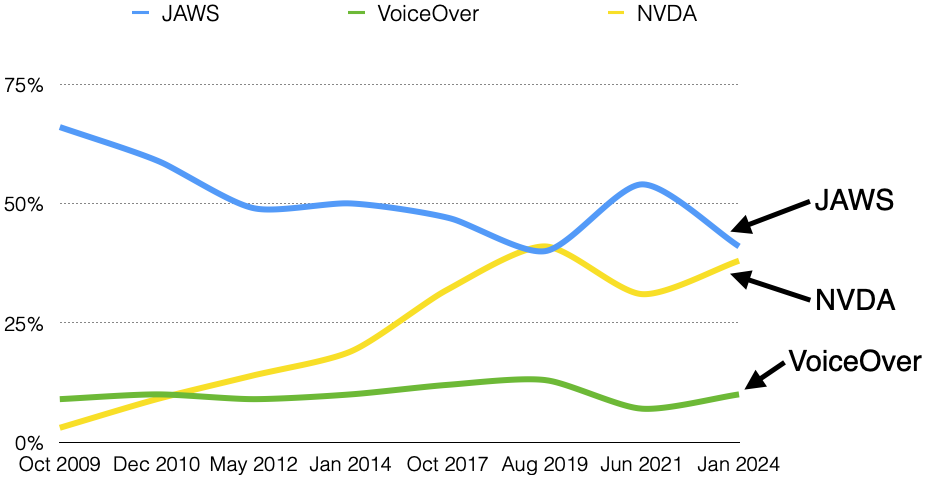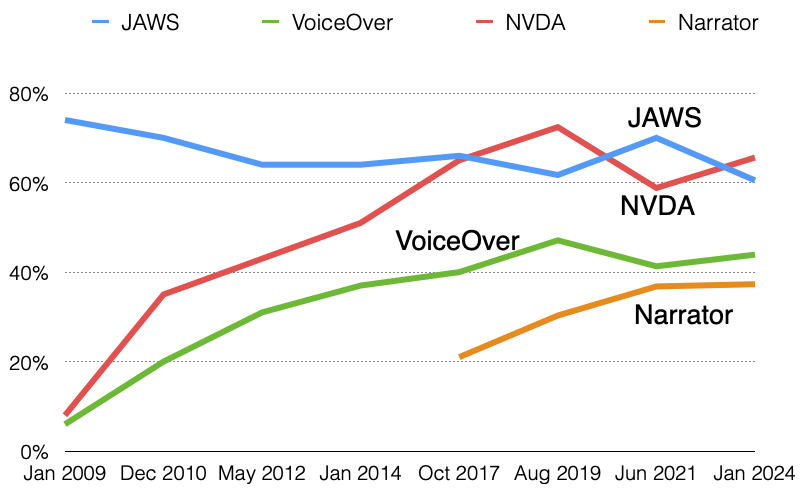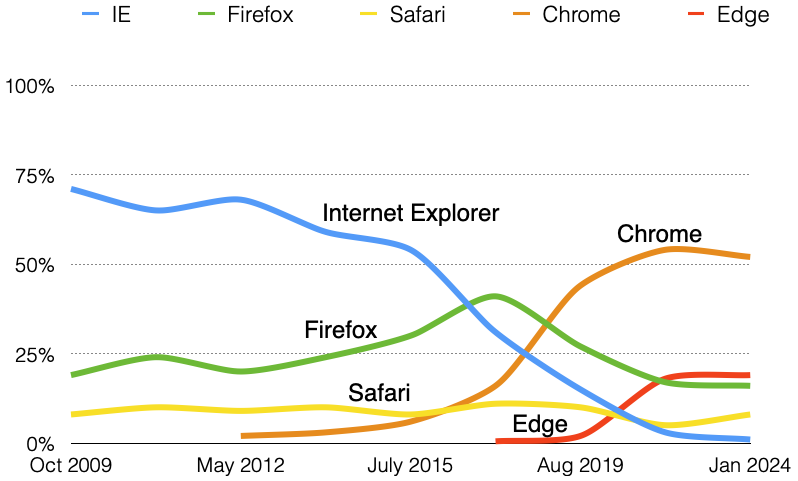Screen Reader User Survey #10 Results
Introduction
In December 2023 and January 2024, WebAIM surveyed preferences of screen reader users. We received 1539 valid responses. This was a follow-up to 9 previous surveys that were conducted between January 2009 and June 2021.
A few disclaimers and notices:
- Totals may not equal 100% due to rounding.
- Total responses (n) for each question may not equal 1539 due to some respondents not answering a particular question.
- The sample was not controlled and may not represent all screen reader users.
- We hope to conduct additional surveys of this nature again in the future. If you have recommendations or questions that you would like us to ask, please contact us.
Demographics
Region
| Region | # of respondents | % of respondents |
|---|---|---|
| North America | 717 | 47.2% |
| Europe | 467 | 30.7% |
| Asia | 97 | 6.4% |
| South America | 96 | 6.3% |
| Africa/Middle East | 73 | 4.8% |
| Australia and Oceania | 50 | 3.3% |
| Central America and Caribbean | 20 | 1.3% |
This survey saw a majority of respondents from outside North America, thus providing better representation of the global screen reader user audience. When survey responses were notably different between regions, this is noted below.
Age
| Age | # of respondents | % of respondents |
|---|---|---|
| Below 20 | 94 | 6.1% |
| 21 - 40 | 584 | 37.9% |
| 41 - 60 | 553 | 35.9% |
| 60+ | 308 | 20.0% |
Disability
| Response | # of Respondents | % of Respondents |
|---|---|---|
| Yes | 1372 | 89.9% |
| No | 154 | 10.1% |
Responses are predominantly very similar for respondents with and without disabilities. Any notable differences are indicated below to highlight differences in practices or perceptions between disabled and non-disabled respondents.
Disability Types
| Response | # of respondents | % of respondents |
|---|---|---|
| Blindness | 1179 | 76.6% |
| Low Vision/Visually-Impaired | 306 | 19.9% |
| Cognitive or Learning | 80 | 5.2% |
| Deafness/Hard-of-Hearing | 104 | 6.8% |
| Motor | 34 | 2.2% |
| Other | 75 | 4.9% |
257 respondents (16.7%) reported multiple disabilities. 81 respondents (5.3%) reported being both deaf/hard-of-hearing and blind.
Screen Reader Proficiency
| Response | # of respondents | % of respondents |
|---|---|---|
| Advanced | 888 | 58.3% |
| Intermediate | 548 | 36.0% |
| Beginner | 87 | 5.7% |
Those who use screen readers due to a disability reported themselves as more proficient with screen readers—63% of those with disabilities considered their proficiency to be "Advanced" compared to only 18.2% of those without disabilities.
Internet Proficiency
| Response | # of respondents | % of respondents |
|---|---|---|
| Advanced | 1091 | 71.8% |
| Intermediate | 401 | 26.4% |
| Beginner | 28 | 1.8% |
Those without disabilities rated themselves as more proficient than those with disabilities.
Primary Desktop/Laptop Screen Reader
| Response | # of respondents | % of respondents |
|---|---|---|
| JAWS | 619 | 40.5% |
| NVDA | 577 | 37.7% |
| VoiceOver | 148 | 9.7% |
| Dolphin SuperNova | 57 | 3.7% |
| ZoomText/Fusion | 41 | 2.7% |
| Orca | 36 | 2.4% |
| Narrator | 10 | 0.7% |
| Other | 41 | 2.7% |
The following chart shows historical trends for primary screen reader usage.

Historically JAWS usage had been in decline until 2019 when JAWS and NVDA were nearly the same. The 2021 survey saw an increase in JAWS usage and decrease in NVDA usage, but in 2024 the usage of both are again nearly the same at 41% for JAWS and 38% for NVDA.
Respondents with disabilities are more likely to use JAWS and NVDA and less likely to use VoiceOver as their primary screen reader than respondents without disabilities. 8.2% of respondents with disabilities primarily use VoiceOver (up from 5.5% in 2021), compared to 23.7% of respondents without disabilities.
Primary usage varied greatly by region. JAWS usage was higher than NVDA in North America (55.5% vs. 24.0%) and Australia (45.8% vs. 37.5%), though JAWS usage was lower than NVDA in Europe (29.7% vs. 37.2%), Africa/Middle East (23.3% vs. 69.9%), and Asia (22.9% vs. 70.8%).
Beyond the three most popular primary screen readers, other screen readers comprised a total of 12.2% of usage.
Screen Readers Commonly Used
| Response | # of respondents | % of respondents |
|---|---|---|
| NVDA | 1009 | 65.6% |
| JAWS | 931 | 60.5% |
| VoiceOver | 675 | 43.9% |
| Narrator | 574 | 37.3% |
| Orca | 127 | 8.3% |
| ZoomText/Fusion | 115 | 7.5% |
| Dolphin SuperNova | 83 | 5.4% |
| ChromeVox | 59 | 3.8% |
| System Access or System Access to Go | 28 | 1.8% |
| Window-Eyes | 18 | 1.2% |
| Other | 79 | 5.1% |

NVDA is again the most commonly used screen reader at 65.6% of respondents outpacing JAWS at 60.5%. Narrator—freely available in Windows for several years—is the primary screen reader of only .7% of respondents, but is commonly used by 37.3% of respondents.
71.6% of respondents use more than one desktop/laptop screen reader. 43% use three or more, and 17.4% use four or more different screen readers. VoiceOver users most commonly use additional screen readers.
Browsers
| Response | # of respondents | % of respondents |
|---|---|---|
| Chrome | 795 | 52.3% |
| Microsoft Edge | 294 | 19.3% |
| Firefox | 243 | 16.0% |
| Safari | 121 | 8.0% |
| Internet Explorer | 14 | .9% |
| Other | 54 | 3.6% |

Browser usage remains mostly unchanged since 2021, with Chrome and Internet Explorer seeing small decreases in usage and Safari a small increase in usage.
Screen Reader / Browser Combinations
| Screen Reader & Browser | # of Respondents | % of Respondents |
|---|---|---|
| JAWS with Chrome | 373 | 24.7% |
| NVDA with Chrome | 323 | 21.3% |
| JAWS with Edge | 173 | 11.4% |
| NVDA with Firefox | 152 | 10.0% |
| VoiceOver with Safari | 107 | 7.0% |
| NVDA with Edge | 75 | 5.0% |
| JAWS with Firefox | 39 | 2.6% |
| VoiceOver with Chrome | 30 | 2.0% |
| Orca with Firefox | 29 | 1.9% |
| Dolphin SuperNova with Chrome | 24 | 1.6% |
| ZoomText/Fusion with Chrome | 18 | 1.2% |
| ZoomText/Fusion with Edge | 16 | 1.1% |
| Other combinations | 154 | 10.2% |
There are many combinations of browsers and screen readers in use, with JAWS with Chrome the most common.
Operating System
| Response | # of respondents | % of respondents |
|---|---|---|
| Windows | 1311 | 86.1% |
| Mac | 146 | 9.6% |
| Linux | 44 | 2.9% |
| Other | 21 | 1.4% |
Respondents without disabilities were nearly 3 times more likely to use Mac OS than respondents with disabilities.
JavaScript
| Response | % of Respondents |
|---|---|
| Yes | 99.8% |
| No | .2% |
JavaScript support was detected with the survey form submission. Nearly all respondents had JavaScript enabled.
Reason for Use
| Response | # of respondents | % of respondents |
|---|---|---|
| Existing Comfort/Expertise | 685 | 45.8% |
| Features | 396 | 26.5% |
| Availability | 175 | 11.7% |
| Cost | 137 | 9.2% |
| Support | 104 | 6.9% |
Existing comfort and features went down slightly, and Availability, Cost, and Support went up slightly.
Screen Reader Satisfaction
| Response | # of respondents | % of respondents |
|---|---|---|
| Very satisfied | 966 | 63.8% |
| Somewhat satisfied | 475 | 31.4% |
| Slightly satisfied | 56 | 3.7% |
| Not satisfied | 18 | 1.2% |
Respondents indicating that they are very or somewhat satisfied by their primary screen reader:
- NVDA - 97.6%
- JAWS - 95.6%
- VoiceOver - 92.4%
- Narrator - 88.9%
Home vs. Work
| Response | # of respondents | % of respondents |
|---|---|---|
| Yes | 266 | 18.6% |
| No | 1165 | 81.4% |
31% of VoiceOver users reported using a different screen reader at work/school vs. home, versus 19% for NVDA, and 15% for JAWS.
Braille Output
| Response | # of respondents | % of respondents |
|---|---|---|
| Yes | 510 | 38% |
| No | 833 | 62% |
Because it would not generally be expected that users without disabilities would use Braille, they have been omitted from these data. Braille usage at 38% is up slightly from 33.3% in 2017 and 27.7% in 2012. 54.2% of VoiceOver users used Braille compared to 42.4% of NVDA users and 35.1% of JAWS users.
Free/Low-cost vs. Commercial
| Response | # of respondents | % of respondents |
|---|---|---|
| Yes | 1171 | 78.1% |
| No | 181 | 12.1% |
| I Don't Know | 148 | 9.9% |
While the positive perception of free or low-cost screen readers has increased significantly from 48% in October 2009, responses to this question over the last several years have been largely unchanged.
Only 67% of JAWS users answered "Yes" compared to an overwhelming 91% of VoiceOver users and 94% of NVDA users. Those that use free or low-cost screen readers as their primary screen reader have a much better perception of them than those who do not. Respondents with "Advanced" screen reader proficiency were also more favorable of free/low-cost screen readers.
Mobile Screen Readers
Mobile Usage
| Response | # of respondents | % of respondents |
|---|---|---|
| Yes | 1379 | 91.3% |
| No | 132 | 8.7% |
91.3% of respondents report using a screen reader on a mobile device. Respondents with disabilities (93.6%) are more likely to use a mobile screen reader than respondents without disabilities (70.4%).
Mobile Platforms
| Response | # of respondents | % of respondents |
|---|---|---|
| Apple iPhone, iPad, or iPod touch | 1048 | 70.6% |
| Android | 409 | 27.6% |
| Chrome OS | 7 | 0.5% |
| Other | 19 | 1.3% |
Respondents with disabilities (72.4%) used iOS devices at a higher rate than those without disabilities (56%). Usage of iOS devices was significantly higher in North America (84%), Australia (75%), and Europe/UK (72%) than in Asia (40%), Africa/Middle East (34%), and South America (31%). Respondents with more advanced screen reader and internet proficiency were much more likely to use iOS over Android.

iOS devices continue to dominate the mobile screen reader market. Usage of platforms other than iOS and Android (Chrome OS, Windows Phone, Nokia, etc.) combined represent only 1.8% of reported usage.
Mobile Screen Readers Used
| Response | % of respondents |
|---|---|
| VoiceOver | 70.6% |
| TalkBack | 34.7% |
| Commentary/Jieshuo | 10.1% |
| Voice Assistant | 6.0% |
| VoiceView | 5.9% |
| Mobile Accessibility for Android | 4.9% |
| Mobile Speak | 1.0% |
| Nuance Talks | 1.0% |
| IDEAL | 0.5% |
| Other | 4.7% |
Primary Mobile Browser
| Response | # of respondents | % of respondents |
|---|---|---|
| Safari | 854 | 58.2% |
| Chrome | 410 | 27.9% |
| Firefox | 68 | 4.6% |
| IE or Edge Mobile | 39 | 2.7% |
| Android Browser | 23 | 1.6% |
| Samsung Browser | 16 | 1.1% |
| Other | 57 | 3.9% |
Safari saw a small decrease in usage while Chrome had a slight increase in usage since 2021.
Mobile vs. Desktop/Laptop Usage
| Responses | # of respondents | % of respondents |
|---|---|---|
| Desktop/laptop | 610 | 40.2% |
| I use mobile/tablet and desktop/laptop screen readers about the same | 751 | 49.5% |
| Mobile/tablet device | 155 | 10.2% |
There was almost no change to responses to this question compared to the 2019 survey.
Mobile App vs Web Site Usage
| Response | # of respondents | % of respondents |
|---|---|---|
| app | 852 | 58% |
| web | 618 | 42% |
Respondents indicated that they are much more likely to use a mobile app than a web site for common online tasks. The preference for mobile app usage increased to 58% in 2024, up from 51.8% in 2021 and 46% in 2017.
Web Accessibility Progress
| Response | # of respondents | % of respondents |
|---|---|---|
| Web content has become more accessible | 522 | 34.6% |
| Web content accessibility has not changed | 707 | 46.8% |
| Web content has become less accessible | 281 | 18.6% |
Perception of the state of web accessibility decreased slightly since 2021. Respondents without disabilities tend to be more positive about recent progress (45.9% thought it has become more accessible) than those with disabilities (33.4% thought it has become more accessible).
Impacts on Accessibility
| Response | # of respondents | % of respondents |
|---|---|---|
| Better assistive technology | 213 | 14.1% |
| Better (more accessible) web sites | 1298 | 85.9% |
Over time, more respondents have answered "better web sites" to this question—68.6% of respondents in October 2009, 75.8% in December 2010, 81.3% in January 2014, 85.3% in 2021, and now 85.9% on this survey. This change may reflect improvements in assistive technology. It certainly indicates that users expect more accessible web sites.
Contacting Website Owners
| Response | # of respondents | % of respondents |
|---|---|---|
| Very often | 137 | 9.2% |
| Somewhat often | 370 | 24.8% |
| Not very often | 661 | 44.3% |
| Never | 324 | 21.7% |
The majority (67%) of respondents never or rarely contact web site owners about barriers. Respondents without disabilities reported nearly the same likelihood to contact website owners as respondents with disabilities.
Descriptions in Virtual Meetings
| Response | # of respondents | % of respondents |
|---|---|---|
| Yes | 363 | 31.8% |
| No | 779 | 68.2% |
The majority (68.2%) of respondents do not prefer descriptions of appearances in online meetings.
Landmarks/Regions
| Response | # of respondents | % of respondents |
|---|---|---|
| Whenever they're available | 268 | 17.9% |
| Often | 208 | 13.9% |
| Sometimes | 471 | 31.5% |
| Seldom | 309 | 20.6% |
| Never | 241 | 16.1% |
After steady decreases in the frequent usage of landmarks/regions was seen from 2014 (43.8%) to 2021 (25.6%). In 2024 the reported frequent usage has now increased to 31.8%.
Finding Information
| Response | # of respondents | % of respondents |
|---|---|---|
| Navigate through the headings on the page | 1082 | 71.6% |
| Read through the page | 96 | 6.4% |
| Use the Find feature | 205 | 13.6% |
| Navigate through the links of the page | 72 | 4.8% |
| Navigate through the landmarks/regions of the page | 56 | 3.7% |
The usage of headings for finding information has increased over time, and it remains the predominant method. Those with advanced screen reader proficiency are much more likely to use headings (78%) than those with beginner proficiency (47%). Beginners are 2.5 times more likely to use the "Find" feature than those with advanced proficiency.
While 31.7% of respondents indicate that they always or often use landmarks when they are present, only 3.7% use this as a primary method for finding information on a lengthy web page.
Heading Levels
| Response | # of respondents | % of respondents |
|---|---|---|
| Very useful | 855 | 57.0% |
| Somewhat useful | 477 | 31.8% |
| Not very useful | 113 | 7.5% |
| Not at all useful | 27 | 1.8% |
| I don't know | 29 | 1.9% |
The reported usefulness of heading levels for navigation has increased over time, and 88.8% of respondents find them very or somewhat useful.
Problematic Items
The survey asked respondents to select their most, second most, and third most problematic items from a list. In giving each selected item a weighting, the following chart shows the overall rating of difficulty and frustration for each item.
In order, the most problematic items are:
- CAPTCHA - images presenting text used to verify that you are a human user
- Interactive elements like menus, tabs, and dialogs do not behave as expected
- Links or buttons that do not make sense
- Screens or parts of screens that change unexpectedly
- Lack of keyboard accessibility
- Images with missing or improper descriptions (alt text)
- Complex or difficult forms
- Missing or improper headings
- Too many links or navigation items
- Complex data tables
- Inaccessible or missing search functionality
- Lack of "skip to main content" or "skip navigation" links
The order and indicated difficulty for the items in this list are largely unchanged over the last 14 years. CAPTCHA remains the most (by a notable margin) problematic item indicated by respondents. Respondents with disabilities were twice as likely to rank CAPTCHA as a problematic item than respondents without disabilities.


Social Media Accessibility
Perceptions of social media accessibility are generally unchanged over the last several years.